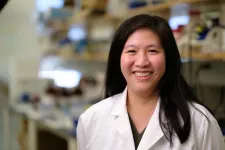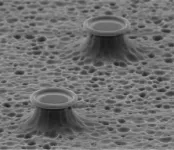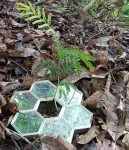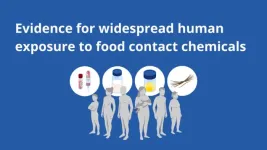(Press-News.org) University of Arizona researchers have developed a new biological sensing method that can detect substances at the zeptomolar level – an astonishingly miniscule amount.
This level of sensing, immediately useful for drug testing and other research, has the potential to make new drug discoveries possible. Eventually, the advance could lead to portable sensors that can detect environmental toxins or chemical weapons, monitor food quality or screen for cancer.
A paper describing the results was published in the journal Nature Communications on Aug. 28.
Judith Su, associate professor of biomedical engineering and optical sciences, led the research for the U of A, collaborating with Stephen Liggett from the University of South Florida. Their method uses the FLOWER device, invented by Su, to pick up target compounds at zeptomolar concentrations and without the current need for labeling, which involves adding a fluorescent or radioactive tag to make a target compound stand out during testing.
Label-free optical tech
Detecting a particular target compound in an environment – or seeing if it reacts with a particular protein – is tricky business. Su, principal investigator at the U of A Little Sensor Lab and a Craig M. Berge Faculty Fellow, said one of the current hurdles to biosensing is that, in the most prevalent technologies, the sensing compounds must be labeled.
FLOWER, an acronym for "frequency locked optical whispering evanescent resonator," is label-free. The sensing substances can be used in their native state to detect a target compound.
"In certain applications, it can be really difficult or impossible to put these tags on, and they can increase cost. For things like small molecule drug screening, sometimes the tags can interfere with the results," said Su, also an associate professor at the university's BIO5 Institute.
FLOWER, which has also been used to detect diseases and toxic gases, uses optical technology. The core of the FLOWER tool is a microtoroid – a glass doughnut supported by a round pedestal. The microtoroid is coated with chemical compounds that capture the target biochemical agents. Its rim guides light in a fashion similar to an optical fiber.
Light of a very specific wavelength will resonate when it passes through the microtoroid. As disease biomarkers or toxic gases get captured, the resonance wavelength shifts slightly. By comparing light that passes through the microtoroid to light that comes directly from a tunable laser, and by locking the tunable laser wavelength to that of the microtoroid resonance, researchers can sense ultra-low concentrations of the targets.
Sensing for drug research
The researchers used G-protein coupled receptors as the sensing compound for their experiments. GPCRs are sometimes referred to as gatekeepers for cells and are the target of 40% of all pharmaceutical drugs. In addition to regulating cell functions, they act as signalers for cells, one of the reasons they are so important for drug research.
For the Nature Communications paper, the researchers looked at the kappa-opioid receptor.
"When something binds to one of these receptors, it triggers a signaling cascade within the cell," said Su. "The kappa-opioid receptor is really important for pain, for example. A future potential application for something like this would be pain relief, but without addictive side effects."
Su says because the FLOWER demonstrates record-level sensitivity in picking up concentrations, its potential use in pharmaceutical research could be a game changer.
Liggett, Su's collaborator and senior vice president for research at the University of Southern Florida's Morsani College of Medicine, concurs with Su's assessment of FLOWER's potential for drug testing. He explained that scientists could potentially find effective drugs they might miss if testing with other methods.
"The ultimate goal of medicinal chemistry is to use all our tools to predict what might be a really good activator of a receptor and build that molecule. Zeptomolar sensitivity is just an incredibly low number, and it has not been achieved by any method we know of to date," he said. "If you come up with a drug that you feel should work at a certain receptor, if it's not a particularly high affinity, then most of the time you can't make a drug out of it because the body can't take huge amounts of a drug.”
An immediate quantum leap
The work is an exciting breakthrough, said Bruce Hay, a professor of biology at Caltech, who studies cellular biology and was not involved with the research. The new method’s label-free high sensitivity makes it immediately useful for advanced drug screening and other research, according to Hay.
"This represents a huge leap in our ability to probe the fundamental components and processes that make up biological systems," he said.
Su and her collaborators at UCLA won a $650,000 Phase 1, National Science Foundation Convergence Accelerator grant last year to continue their investigations. Convergence Accelerator grants are awarded specifically to speed scientific research likely to produce beneficial applications for society.
"Dr. Su's FLOWER sensor offers a quantum leap on peak sensitivity of label-free biosensing," said Mario Romero-Ortega, head of the U of A Department of Biomedical Engineering. "This technology will allow a deeper understanding of membrane molecular events, enable early diagnostic assays and improve human health."
END
Researchers take power and efficiency of biological sensing to record level
The approach could could lead to better health outcomes and diagnostics.
2024-09-17
ELSE PRESS RELEASES FROM THIS DATE:
Under-plant mirrors improve endangered plant survival and growth
2024-09-17
The most endangered plant species in the Mariana Islands, the legume tree Serianthes nelsonii, faces persistent threats in its recovery. These have been identified as a short lifespan of habitat seedlings and rapid death of saplings transplanted from conservation nurseries.
The Plant Physiology Laboratory at the University of Guam addressed this conundrum by improving growth and survival of Serianthes seedlings through strategically placed mirrors beneath deeply shaded seedlings to increase available ambient light. The resulting paper has been published ...
Widespread evidence for packaging-related chemicals in humans
2024-09-17
About this study: A new review is the first to reveal the extent of human exposure to food contact chemicals (FCC), with 3,601 chemicals used in food packaging and other food contact articles having been found in human bodies. The authors say this review also highlights significant gaps in biomonitoring and toxicity data.
---
In a new study, published in the Journal of Exposure Science and Environmental Epidemiology, scientists describe the widespread human exposure to food contact chemicals (FCCs). The research reveals which chemicals ...
Hardship early in life can affect health and longevity – even for marmots
2024-09-16
Key takeaways
The cumulative adversity index for people quantifies numerous measures of hardship, such as poverty and stress to understand health and longevity over the individual’s lifespan.
A similar tool could help scientists who study and want to conserve animal populations by identifying the most influential stressors to mitigate.
UCLA biologists have created the first cumulative adversity index for yellow-bellied marmots. They found that as in humans, adversity early on had lifelong consequences and reduced their life expectancy.
Adversity early in life can have permanent health consequences for people — even if their circumstances improve dramatically later on. ...
Chances of successful pregnancy are the same with embryo transfer on day three or five
2024-09-16
In IVF treatment, embryos are traditionally transferred in the uterus three days after fertilization. Due to improvements in laboratory techniques, this is now also possible after five days. It was assumed that this increases the chance of a successful pregnancy. A study by Radboud university medical center and Amsterdam UMC shows that the day of transfer does not influence the success rate of the IVF trajectory.
One out of thirty children in the Netherlands is conceived via in vitro fertilization, or IVF for short. In this procedure, ...
The Lancet: More than 39 million deaths from antibiotic-resistant infections estimated between now and 2050, suggests first global analysis
2024-09-16
Embargoed access to the paper and contact details for authors are available in Notes to Editors at the end of the release.
The Lancet: More than 39 million deaths from antibiotic-resistant infections estimated between now and 2050, suggests first global analysis
First in-depth analysis of global health impacts of antimicrobial resistance (AMR) over time reveals trends from 1990 to 2021 and estimates potential impacts to 2050 for 204 countries and territories.
More than one million people died from AMR globally each year between 1990 and 2021. Over the period, AMR deaths among children aged under five declined by 50% while those among people aged 70 ...
Fraunhofer IAF low-noise amplifiers aboard the Arctic Weather Satellite
2024-09-16
The Arctic Weather Satellite (AWS) of the European Space Agency (ESA) was sent on its journey to a polar orbit 600 km above the Earth on August 16, 2024. On board: four low-noise amplifiers (LNAs) from the Fraunhofer Institute for Applied Solid State Physics IAF in Freiburg. They are essential components of the passive microwave radiometer with which the AWS measures temperature and humidity in the Arctic more precisely than ever before. This should contribute to a better understanding of both the Arctic and the climate change that is particularly visible in it. If the mission is successful, ...
Immunotherapy after surgery helps people with high-risk bladder cancer live cancer-free longer
2024-09-16
Results from a large clinical trial show that treatment with an immunotherapy drug may nearly double the length of time people with high-risk, muscle-invasive bladder cancer are cancer-free following surgical removal of the bladder. Researchers found that postsurgical treatment with pembrolizumab (Keytruda), which is approved by the Food and Drug Administration (FDA) for treating at least 18 different cancers, was superior compared with observation. The study, led by researchers at the National Institutes of Health (NIH), ...
US COVID-19 rates oscillate every six months
2024-09-16
COVID-19 cases in the U.S. have shown unexpected oscillating waves every six months between the southern states and the northern states and, to a lesser degree, from east to west, according to new research published today in Scientific Reports.
Public health scientists from the University of Pittsburgh, University of Ottawa and University of Washington conducted the first detailed analysis to demonstrate and characterize the six-month oscillation of cases across space and time. It provides key information ...
Lower neighborhood opportunity may increase risk for preterm birth
2024-09-16
FOR IMMEDIATE RELEASE
Monday, September 16, 2024
Contact:
Jillian McKoy, jpmckoy@bu.edu
Michael Saunders, msaunder@bu.edu
##
Lower Neighborhood Opportunity May Increase Risk for Preterm Birth
A new study suggests that neighborhoods with fewer educational, health, environmental, and socioeconomic resources may increase one’s risk for preterm birth and contribute to the racial gap in preterm birth in the Commonwealth.
Preterm birth, defined as a live birth before 37 weeks of pregnancy, is the second-leading cause of infant mortality in the United States, and one that disproportionately affects Black and ...
Analysis finds cardiac devices recalled for safety reasons infrequently subjected to premarket or postmarket testing
2024-09-16
Embargoed for release until 5:00 p.m. ET on Monday 16 September 2024
@Annalsofim
Below please find summaries of new articles that will be published in the next issue of Annals of Internal Medicine. The summaries are not intended to substitute for the full articles as a source of information. This information is under strict embargo and by taking it into possession, media representatives are committing to the terms of the embargo not only on their own behalf, but also on behalf of the organization they represent.
----------------------------
1. ...
LAST 30 PRESS RELEASES:
Tracing the quick synthesis of an industrially important catalyst
New software sheds light on cancer’s hidden genetic networks
UT Health San Antonio awarded $3 million in CPRIT grants to bolster cancer research and prevention efforts in South Texas
Third symposium spotlights global challenge of new contaminants in China’s fight against pollution
From straw to soil harmony: International team reveals how biochar supercharges carbon-smart farming
Myeloma: How AI is redrawing the map of cancer care
Manhattan E. Charurat, Ph.D., MHS invested as the Homer and Martha Gudelsky Distinguished Professor in Medicine at the University of Maryland School of Medicine
Insilico Medicine’s Pharma.AI Q4 Winter Launch Recap: Revolutionizing drug discovery with cutting-edge AI innovations, accelerating the path to pharmaceutical superintelligence
Nanoplastics have diet-dependent impacts on digestive system health
Brain neuron death occurs throughout life and increases with age, a natural human protein drug may halt neuron death in Alzheimer’s disease
SPIE and CLP announce the recipients of the 2025 Advanced Photonics Young Innovator Award
Lessons from the Caldor Fire’s Christmas Valley ‘Miracle’
Ant societies rose by trading individual protection for collective power
Research reveals how ancient viral DNA shapes early embryonic development
A molecular gatekeeper that controls protein synthesis
New ‘cloaking device’ concept to shield sensitive tech from magnetic fields
Researchers show impact of mountain building and climate change on alpine biodiversity
Study models the transition from Neanderthals to modern humans in Europe
University of Phoenix College of Doctoral Studies releases white paper on AI-driven skilling to reduce burnout and restore worker autonomy
AIs fail at the game of visual “telephone”
The levers for a sustainable food system
Potential changes in US homelessness by ending federal support for housing first programs
Vulnerability of large language models to prompt injection when providing medical advice
Researchers develop new system for high-energy-density, long-life, multi-electron transfer bromine-based flow batteries
Ending federal support for housing first programs could increase U.S. homelessness by 5% in one year, new JAMA study finds
New research uncovers molecular ‘safety switch’ shielding cancers from immune attack
Bacteria resisting viral infection can still sink carbon to ocean floor
Younger biological age may increase depression risk in older women during COVID-19
Bharat Innovates 2026 National Basecamp Showcases India’s Most Promising Deep-Tech Ventures
Here’s what determines whether your income level rises or falls
[Press-News.org] Researchers take power and efficiency of biological sensing to record levelThe approach could could lead to better health outcomes and diagnostics.




